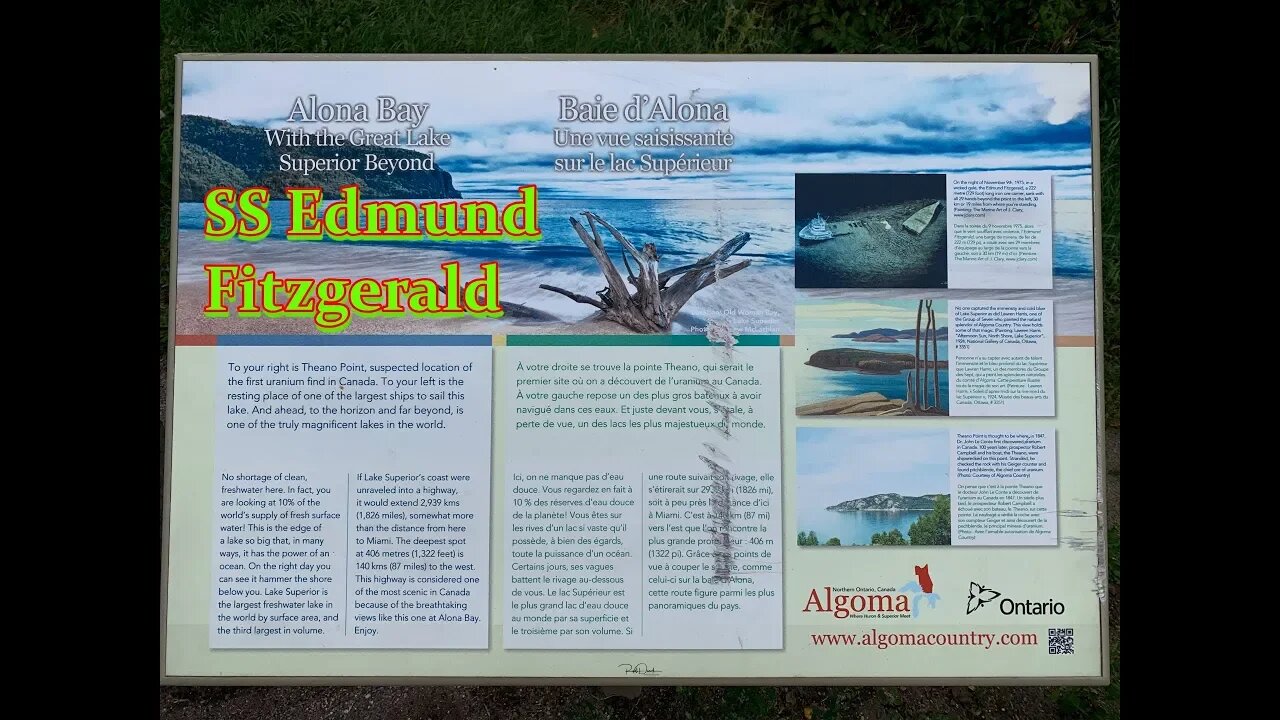Premium Only Content

SS Edmund Fitzgerald Wicked The Outdoor Adventures Vlog#1866
The Alona Bay ONT SS Edmund Fitzgerald Wicked
From The Outdoor Adventures across the World.
Subscribe to My YouTube Channel Click the Link Below to Subscribe don't forget to Hit the Little Bell Icon.
https://www.youtube.com/channel/UCm8OYSHT-zANaV8LpTOLPew?sub_confirmation=1&via=tb
https://goo.gl/YnonWF
"Edmund Fitzgerald" redirects here. For other uses, see Edmund Fitzgerald (disambiguation).
Edmund Fitzgerald, 1971, Edmund Fitzgerald in 1971
History
Name: Edmund Fitzgerald
Owner: Northwestern Mutual Life Insurance Company
Operator: Columbia Transportation Division, Oglebay Norton Company of Cleveland, Ohio
Port of registry: United States
Ordered: February 1, 1957
Builder: Great Lakes Engineering Works of River Rouge, Michigan
Yard number: 301
Laid down: August 7, 1957
Launched: June 7, 1958
Christened: June 7, 1958
Maiden voyage: September 24, 1958
In service: June 8, 1958
Out of service: November 10, 1975
Identification: Registry number US 277437
Nickname(s): Fitz, Mighty Fitz, Big Fitz, Pride of the American Side, Toledo Express, Titanic of the Great Lakes
Fate: Lost in a storm on November 10, 1975, with all 29 crew members
Status: Wreck
Notes: Location: 46°59.91′N 85°06.61′WCoordinates: 46°59.91′N 85°06.61′W[1]
General characteristics
Type: Lake freighter
Tonnage:
13,632 GRT[2]
8,713 NRT (from 1969: 8,686 NRT)[2]
26,000 DWT
Length:
729 ft (222 m) overall[3]
711 ft (217 m) between perpendiculars[3]
Beam: 75 ft (23 m)[3]
Draft: 25 ft (7.6 m) typical
Depth: 39 ft (12 m) (moulded)[4]
Depth of hold: 33 ft 4 in (10.16 m)[4][5]
Installed power:
As built:
Coal fired Westinghouse Electric Corporation steam turbine at 7,500 shp (5,600 kW)
After refit:
Conversion to oil fuel and the fitting of automated boiler controls over the winter of 1971–72.
Carried 72,000 U.S. gal (270,000 L; 60,000 imp gal) fuel oil
Propulsion: Single fixed pitch 19.5 ft (5.9 m) propeller
Speed: 14 kn (26 km/h; 16 mph)
Capacity: 25,400 tons of cargo
Crew: 29
SS Edmund Fitzgerald was an American Great Lakes freighter that sank in a Lake Superior storm on November 10, 1975, with the loss of the entire crew of 29. When launched on June 7, 1958, she was the largest ship on North America's Great Lakes, and she remains the largest to have sunk there.
For 17 years, Edmund Fitzgerald carried taconite iron ore from mines near Duluth, Minnesota, to iron works in Detroit, Toledo, and other Great Lakes ports. As a workhorse, she set seasonal haul records six times, often breaking her own previous record. Captain Peter Pulcer was known for piping music day or night over the ship's intercom while passing through the St. Clair and Detroit Rivers (between Lakes Huron and Erie), and entertaining spectators at the Soo Locks (between Lakes Superior and Huron) with a running commentary about the ship.[5] Her size, record-breaking performance, and "DJ captain" endeared Edmund Fitzgerald to boat watchers.
Carrying a full cargo of ore pellets with Captain Ernest M. McSorley in command, she embarked on her ill-fated voyage from Superior, Wisconsin, near Duluth, on the afternoon of November 9, 1975. En route to a steel mill near Detroit, Edmund Fitzgerald joined a second freighter, SS Arthur M. Anderson. By the next day, the two ships were caught in a severe storm on Lake Superior, with near hurricane-force winds and waves up to 35 feet (11 m) high. Shortly after 7:10 p.m., Edmund Fitzgerald suddenly sank in Canadian (Ontario) waters 530 feet (88 fathoms; 160 m) deep, about 17 miles (15 nautical miles; 27 kilometers) from Whitefish Bay near the twin cities of Sault Ste. Marie, Michigan, and Sault Ste. Marie, Ontario—a distance Edmund Fitzgerald could have covered in just over an hour at her top speed. Although Edmund Fitzgerald had reported being in difficulty earlier, no distress signals were sent before she sank; Captain McSorley's last message to Arthur M. Anderson said, "We are holding our own." Her crew of 29 perished, and no bodies were recovered. The exact cause of the sinking remains unknown, though many books, studies, and expeditions have examined it. Edmund Fitzgerald may have been swamped, suffered structural failure or topside damage, been shoaled, or suffered from a combination of these.
The disaster is one of the best-known in the history of Great Lakes shipping. Gordon Lightfoot made it the subject of his 1976 hit song "The Wreck of the Edmund Fitzgerald" after reading an article, "The Cruelest Month", in the November 24, 1975, issue of Newsweek. The sinking led to changes in Great Lakes shipping regulations and practices that included mandatory survival suits, depth finders, positioning systems, increased freeboard, and more frequent inspection of vessels.
You can Email: cawaljero@gmail.com
Instagram @ RudiDueckPhotography
https://www.instagram.com/rudidueckphotography/
#SSEdmundFitzgeraldWicked
#EdmundFitzgerald
#ShipWicked
-
 55:40
55:40
Nomad Outdoor Adventures
7 months agoCave of the Mounds EXPLORED! Wisconsin's Hidden Treasure
311 -
 4:57
4:57
Mkelley1
3 years agoEaster in Ostrander, Ohio 2022... Kelley's Outdoor Adventures
11 -
 0:58
0:58
RedRobby
3 years agoOutdoor Adventures with Rob
27 -
 13:27
13:27
Mkelley1
3 years ago $0.01 earnedSedona AZ, Trolly Tour and Wild Pigs... Kelley's Outdoor Adventures
131 -
 3:50
3:50
RVdrifters
2 years agoLogan County Fair Tractor Pulls 2022. Kelley's Outdoor Adventures
18 -
 5:28
5:28
Mikey666
3 years agoThe Wreck of the Edmund Fitzgerald
51 -
 11:37
11:37
Easy Guitar Lessons
3 years ago $0.04 earnedEasy Guitar 4 chords, Wreck of the Edmund Fitzgerald. Beginner Guitar
184 -
 43:55
43:55
pewculture
6 days ago $0.17 earnedIf the Purge was real, this is what we'd do... - EP#24
1.89K3 -
 8:14
8:14
MattMorseTV
1 day ago $8.38 earnedTrump just DROPPED the HAMMER.
47.3K59 -
 LIVE
LIVE
Lofi Girl
2 years agoSynthwave Radio 🌌 - beats to chill/game to
185 watching